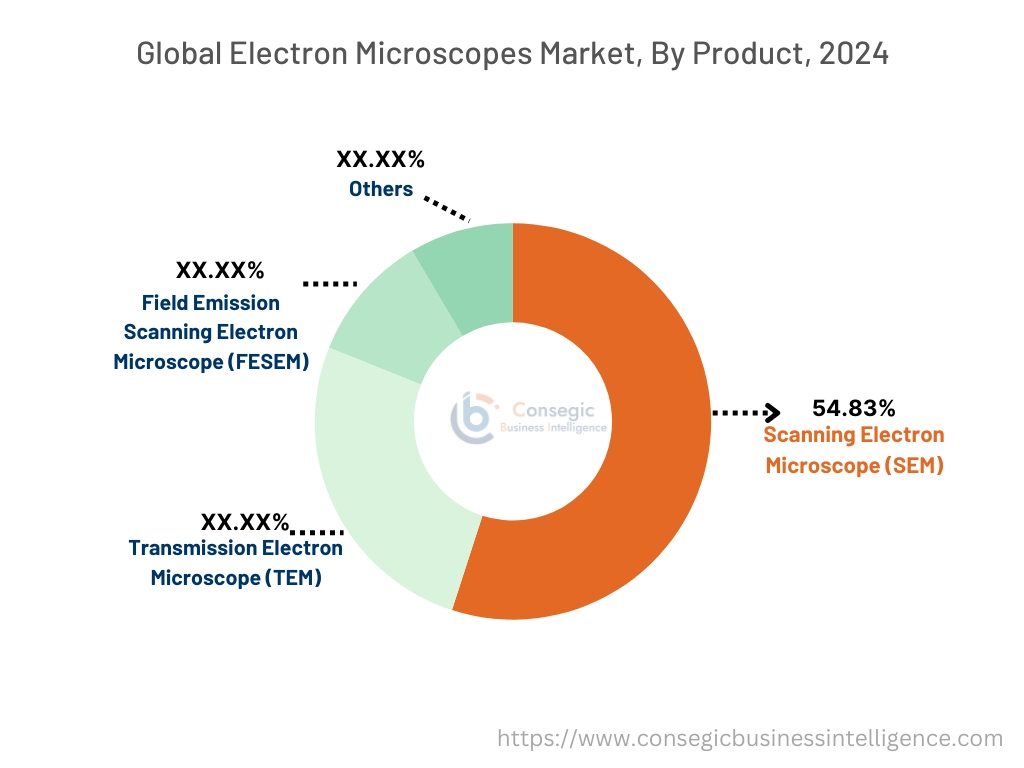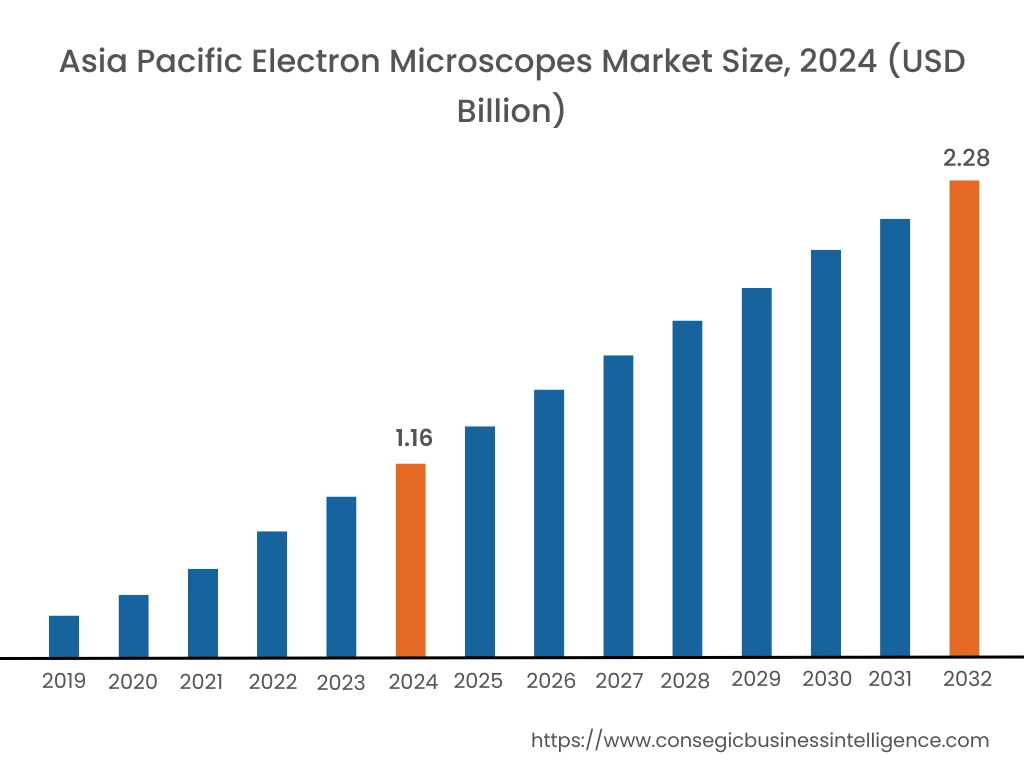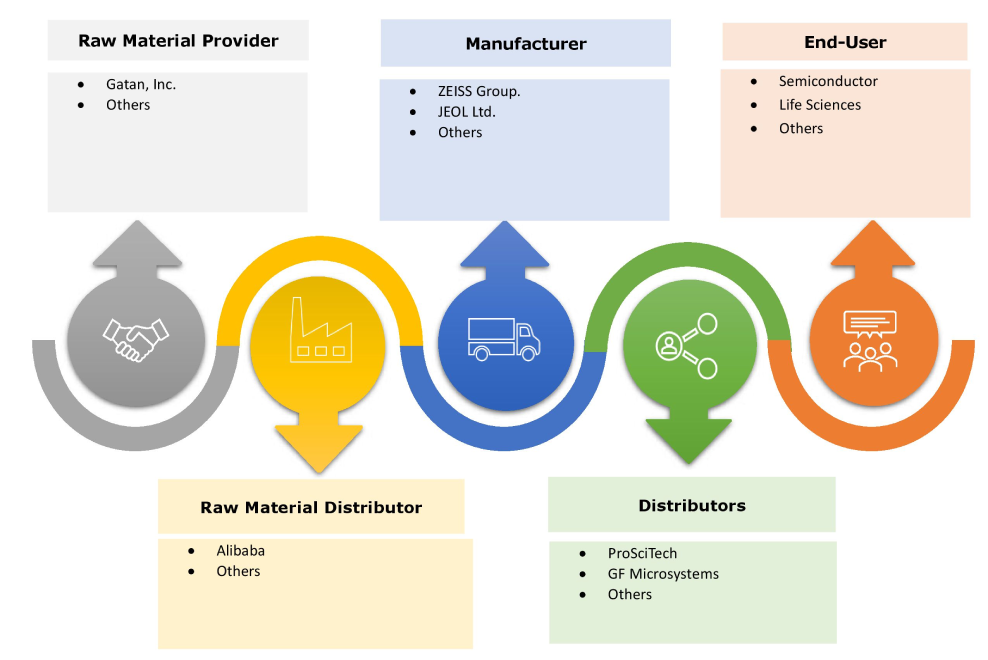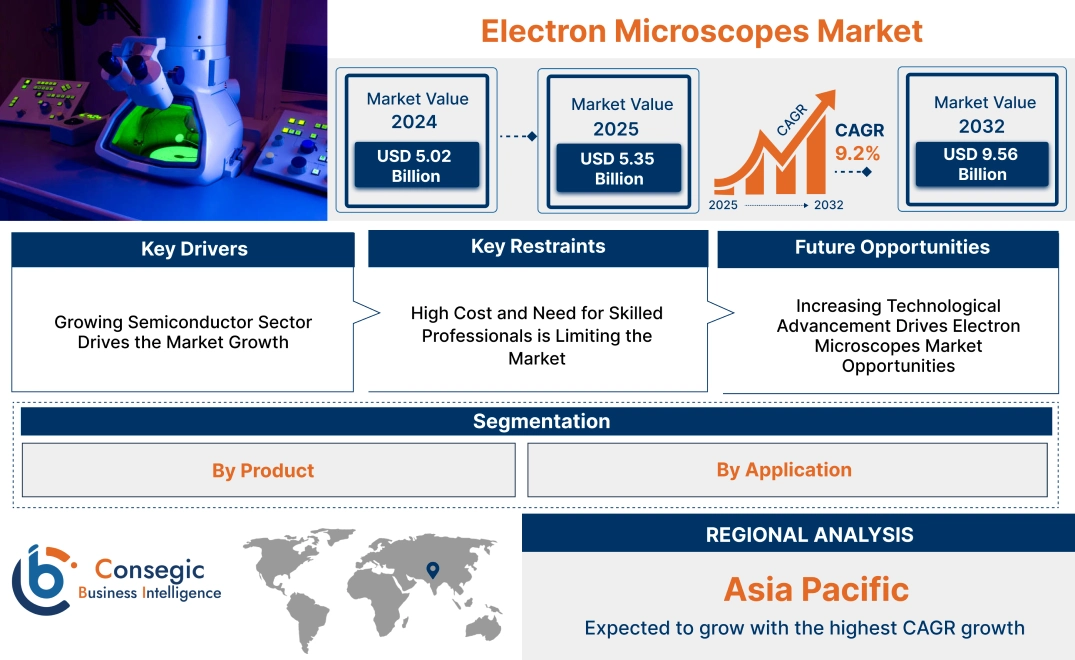- Summary
- Table Of Content
- Methodology
Electron Microscopes Market Size:
Electron Microscopes Market is estimated to reach over USD 9.56 Billion by 2032 from a value of USD 5.02 Billion in 2024 and is projected to grow by USD 5.35 Billion in 2025, growing at a CAGR of 9.2% from 2025 to 2032.
Electron Microscopes Market Scope & Overview:
An electron microscope is an instrument that uses a beam of electrons to create highly magnified images of specimens, allowing scientists to observe structures at a much finer resolution than traditional light microscopes. Technology enables the visualization of details at a nanometer and even atomic level. Further, the benefits of using the instrument include higher magnification and resolution and detailed visualization of nanoscale structures. Furthermore, key trends driving the electron microscope market include advancements in cryo-electron microscopy, integration of AI and automation, and the development of higher-resolution imaging techniques for materials science and nanotechnology.
Key Drivers:
Growing Semiconductor Sector Drives the Market Growth
The semiconductor sector's focus on miniaturization and enhanced performance directly fuels the electron microscopes market growth. Microscopes are indispensable for quality control, failure analysis, and research into new materials and processes. Further, the drive towards smaller nodes such as 3nm and beyond, necessitates detailed characterization of materials at the atomic level. Further, the rising adoption of advanced lithography techniques requires precise imaging for process optimization, making the microscope a crucial tool in the semiconductor manufacturing ecosystem.
- For instance, according to the Semiconductor Industry Association, global semiconductor sales reached USD 56.5 billion in January 2025, demonstrating a substantial 17.9% rise compared to the USD 47.9 billion recorded in the same month during 2024.
Thus, growing semiconductor applications in consumer electronics, automotive, aerospace, and other sectors is driving the semiconductor market which significantly to the electron microscopes market size.
Key Restraints:
High Cost and Need for Skilled Professionals is Limiting the Market
The significant capital investment required for purchasing and maintaining advanced electron microscopes presents a substantial barrier to market growth. The necessity for highly skilled professionals to operate and interpret data from these complex instruments also acts as a barrier to the market. Further, the intricate nature of electron microscopy demands specialized training limiting the pool of qualified personnel. This creates a bottleneck, particularly for smaller research institutions and industries with budget constraints. The high operational costs, including maintenance and specialized software, further exacerbate the financial burden. Thus, the scarcity of skilled operators and the high cost of training contribute to the slowing of the electron microscopes market growth.
Future Opportunities :
Increasing Technological Advancement Drives Electron Microscopes Market Opportunities
Technological advancements are significantly expanding opportunities within electron microscopes. Innovations in cryo-electron microscopy, for instance, are revolutionizing structural biology, enabling the visualization of biological molecules at near-atomic resolution. The integration of artificial intelligence and automation streamlines workflows and enhances efficiency which is crucial for high-volume research and industrial applications. Further, the development of advanced detectors and imaging systems pushes the boundaries of resolution and sensitivity, opening new avenues in materials science and nanotechnology.
Furthermore, enhanced software, with advanced image processing and analysis capabilities, allows more detailed data extraction. These developments lead to wider applications in diverse sectors, from pharmaceuticals and semiconductors to materials research and environmental science, creating a dynamic and expanding market landscape. Thus, growing developments lead to wider applications in sectors including pharmaceuticals, semiconductors, materials research, and environmental science which in turn drives the electron microscopes market opportunities
Electron Microscopes Market Segmental Analysis :
By Product:
Based on the product, the market is segmented into Scanning electron microscope (SEM), Transmission electron microscope (TEM), Field emission scanning electron microscope (FESEM), and others.
Trends in the Product:
- Increasing growth of compact or "tabletop" scanning electron microscope for laboratories with limited space in turn driving the electron microscopes market trends.
- Growing improvements in electron source stability and system performance is expected to drive electron microscopes market size.
Scanning electron microscope (SEM) accounted for the largest revenue share of 54.83% in the year 2024.
- Increasing integration of artificial intelligence (AI) and machine learning algorithms for data analysis is driving the electron microscopes market share.
- Further, there is an increasing trend of development of detectors and electron optics to achieve higher resolution.
- Furthermore, growing development of more intuitive software and user interfaces drives electron microscopes market trends.
- For instance, JEOL Ltd offers JSM-IT510 InTouchScope Scanning Electron Microscope that improves efficiency and ease of use by automating repetitive observation processes, making it easier to acquire data for all specimen types.
- Thus, as per electron microscopes market analysis, automation and AI enhanced resolution, and user-friendly interfaces are driving the market.
Transmission electron microscope (TEM) is anticipated to register the fastest CAGR during the forecast period.
- The rise of 4D-STEM for the study of materials’ electronic and atomic structures drives the electron microscopes market share.
- Further, growing use of in-situ TEM for the observation of dynamic processes such as chemical reactions and material transformations in real time which in turn drives the electron microscopes market demand.
- For instance, Hitachi offers Field Emission Transmission Electron Microscope HF5000 that features a new, high-stability side-entry specimen stage, symmetrically opposed dual EDX detectors for enhanced analysis, and a newly designed enclosure for optimal laboratory performance.
- Therefore, rise of 4D-STEM and growing use of in-situ TEM is anticipated to boost the market during the forecast period.

By Application:
Trends in the Application:
- Growing use of the technology for creating detailed 3D models of cells and tissues to understand their complex organization which in turn drives the electron microscopes market demand.
- Increasing use in forensic science for evidence investigation is expected to drive the market.
Semiconductor accounted for the largest revenue share in the year 2024.
- Growing adoption of electron microscopy to identify defects and failures in semiconductor devices drives the market.
- Further, growing use in monitoring the manufacturing process of semiconductor devices to ensure accuracy and consistency drives the electron microscopes industry.
- Furthermore, growing consumer electronics sector is driving the demand for semiconductors, which in turn drives the electron microscopes market expansion.
- For instance, Thermo Fisher Scientific Inc. offers Scanning Electron Microscopy (SEM) for semiconductors’ study. The equipment is used for a wide range of applications from general imaging to advanced failure analysis.
- Thus, failure analysis, process control, and growing consumer electronics sector are driving the market.
Nanotechnology is anticipated to register the fastest CAGR during the forecast period.
- Increasing use of electron microscopes to manipulate individual atoms and molecules for creating nanoscale devices drives the market.
- Further, growing adoption of nanotechnology in applications including healthcare, consumer electronics, and others propels the electron microscopes market expansion.
- Furthermore, rising use of electron microscopy to study and create new nanomaterials with unique properties which in turn drives the market.
- Therefore, based on analysis, aforementioned factors are anticipated to boost the growth of the market during the forecast period.
Regional Analysis:
The regions covered are North America, Europe, Asia Pacific, the Middle East and Africa, and Latin America.

Asia Pacific region was valued at USD 1.16 Billion in 2024. Moreover, it is projected to grow by USD 1.24 Billion in 2025 and reach over USD 2.28 Billion by 2032. Out of this, China accounted for the maximum revenue share of 34.19%. The market growth for electron microscopes is mainly driven by increasing research and development activities particularly in nanotechnology and life sciences, coupled with rising investments and government initiatives supporting these fields.
- For instance, in May 2024, Hitachi High-Tech released SU3900SE and SU3800SE high-resolution scanning electron microscopes designed for precise nanoscale imaging of large, heavy samples.

North America is estimated to reach over USD 3.69 Billion by 2032 from a value of USD 1.95 Billion in 2024 and is projected to grow by USD 2.08 Billion in 2025. The North American market is primarily driven by significant investments in research and development in nanotechnology sector and a strong presence of key industry players.
- For instance, in July 2023, JEOL Ltd. launched two new scanning electron microscopes, the JSM-IT710HR and the JSM-IT210 featuring advanced automation and imaging capabilities.
The regional trends study depicts that growing semiconductor and life sciences sector in Europe is driving the market. Additionally, the factor driving the market in the Middle East and African region is demand for detailed and precise imaging across nanotechnology, materials science, and life sciences. Further, expansion of healthcare infrastructure and a growing focus on technological advancements is paving the way for the progress of market trends in Latin America region.
Top Key Players and Market Share Insights:
The global electron microscopes market is highly competitive with major players providing solutions to the national and international markets. Key players are adopting several strategies in research and development (R&D), product innovation, and end-user launches to hold a strong position in the electron microscopes industry. Key players in the global electron microscopes market include-
- ZEISS Group (Germany)
- JEOL Ltd. (Japan)
- COXEM Co., Ltd. (South Korea)
- Thermo Fisher Scientific Inc. (US)
- Hitachi High-Technologies Corporation (Japan)
- Bruker Corporation (US)
- Oxford Instruments plc (UK)
- Leica Microsystems (Germany)
- AMETEK Inc. (US)
- Nikon Instruments, Inc. (Japan)
- Advantest Corporation (Japan)
- Tescan Orsay Holding, a.s. (Czech Republic)
Electron Microscopes Market Ecosystem:

Recent Industry Developments :
Collaborations and Partnerships:
- In March 2025, Shimadzu Corporation and TESCAN launched their first co-branded SEM, the "SUPERSCAN SS-4000," in Japan. The series is designed for easier sample handling and advanced imaging.
Product Launch:
- In May 2024 JEOL Ltd. released the JEM-120i electron microscope focusing on "compact," "easy to use," and "expandable" design principles. This next-generation microscope caters to the growing demand for accessible electron microscopy in diverse research and testing areas, simplifying operation and maintenance for all users.
Electron Microscopes Market Report Insights :
| Report Attributes | Report Details |
| Study Timeline | 2019-2032 |
| Market Size in 2032 | USD 9.56 Billion |
| CAGR (2025-2032) | 9.2% |
| By Product |
|
| By Application |
|
| By Region |
|
| Key Players |
|
| North America | U.S. Canada Mexico |
| Europe | U.K. Germany France Spain Italy Russia Benelux Rest of Europe |
| APAC | China South Korea Japan India Australia ASEAN Rest of Asia-Pacific |
| Middle East and Africa | GCC Turkey South Africa Rest of MEA |
| LATAM | Brazil Argentina Chile Rest of LATAM |
| Report Coverage |
|
Key Questions Answered in the Report
How big is the electron microscopes market? +
The electron microscopes market is estimated to reach over USD 9.56 Billion by 2032 from a value of USD 5.02 Billion in 2024 and is projected to grow by USD 5.35 Billion in 2025, growing at a CAGR of 9.2% from 2025 to 2032.
What specific segmentation details are covered in the electron microscopes report? +
The electron microscopes report includes specific segmentation details for product, application, and regions.
Which is the fastest segment anticipated to impact the market growth? +
In the electron microscopes market, Transmission electron microscope (TEM) is the fastest-growing segment during the forecast period.
Who are the major players in the electron microscopes market? +
The key participants in the electron microscopes market are ZEISS Group (Germany), JEOL Ltd. (Japan), COXEM Co., Ltd. (South Korea), Thermo Fisher Scientific Inc. (US), Hitachi High-Technologies Corporation (Japan), Bruker Corporation (US), Oxford Instruments plc (UK), Leica Microsystem (Germany), AMETEK Inc. (US), Nikon Instruments, Inc. (Japan), Advantest Corporation (Japan), Tescan Orsay Holding, a.s. (Czech Republic), and others.
What are the key trends in the electron microscopes market? +
The electron microscopes market is being shaped by several key trends including technological advancements in chassis design, growing electric vehicle market, and adoption of autonomous vehicles.


